If there’s one ever-present breakfast dish in a Maharashtrian household, it has to be the Poha. Poha recipe with its few versions like Kanda Poha, Dadpe Pohe and Indori Poha – is the staple preparation with flattened rice, herbs and spices. This Kanda Poha recipe is a comforting and tasty Pohe made with onions, potatoes, peanuts plus the usual Indian spices and herbs. The recipe is naturally vegan and gluten-free.
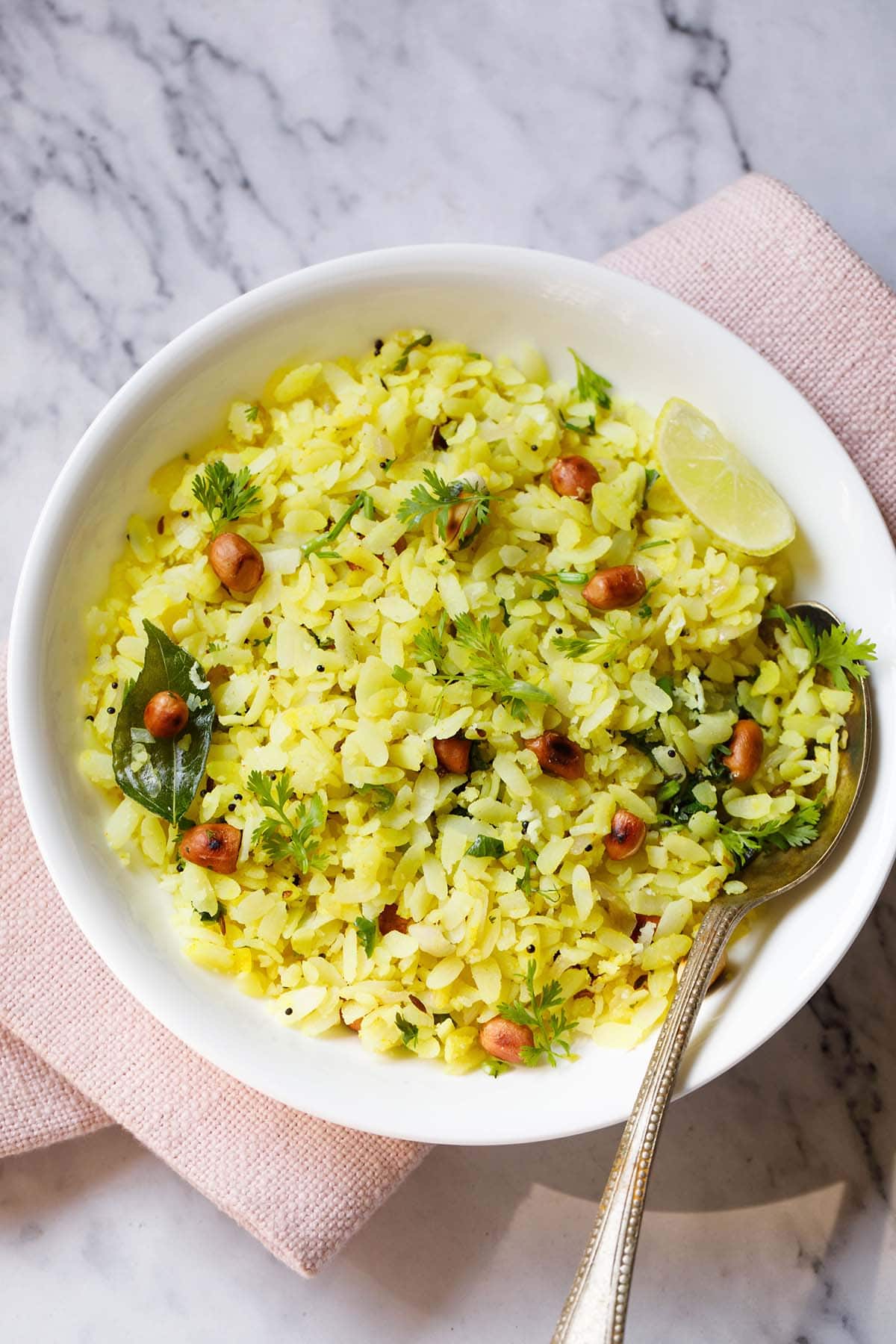
About Poha
The word Poha (plural: pohe) refers to 2 things – the first one is the ingredient; flattened rice itself and the second one is the Poha recipe or the dish that is made with this particular ingredient.
Easy to remember, make and tastes fab. No confusions there, right?
As mentioned above, both the ingredient and dish are a super common feature in Maharashtra, as well as then neighboring Indian states of Madhya Pradesh, Gujarat and Goa too.
It even reaches the south in Karnataka and Telangana, north in Rajasthan and east in West Bengal and Odisha. The dish is also consumed as a snack in these states.
Table of Contents
In Maharashtra, the 2 customary variations of the Poha recipe are either made with onions or both onions and potatoes. Kanda Poha (with onions) and Kanda Batata Poha (with onions and potatoes) is what they are locally known as.
Here you’ll find the recipe featuring both onions and potatoes, which you can further modify as per what suits your taste buds.
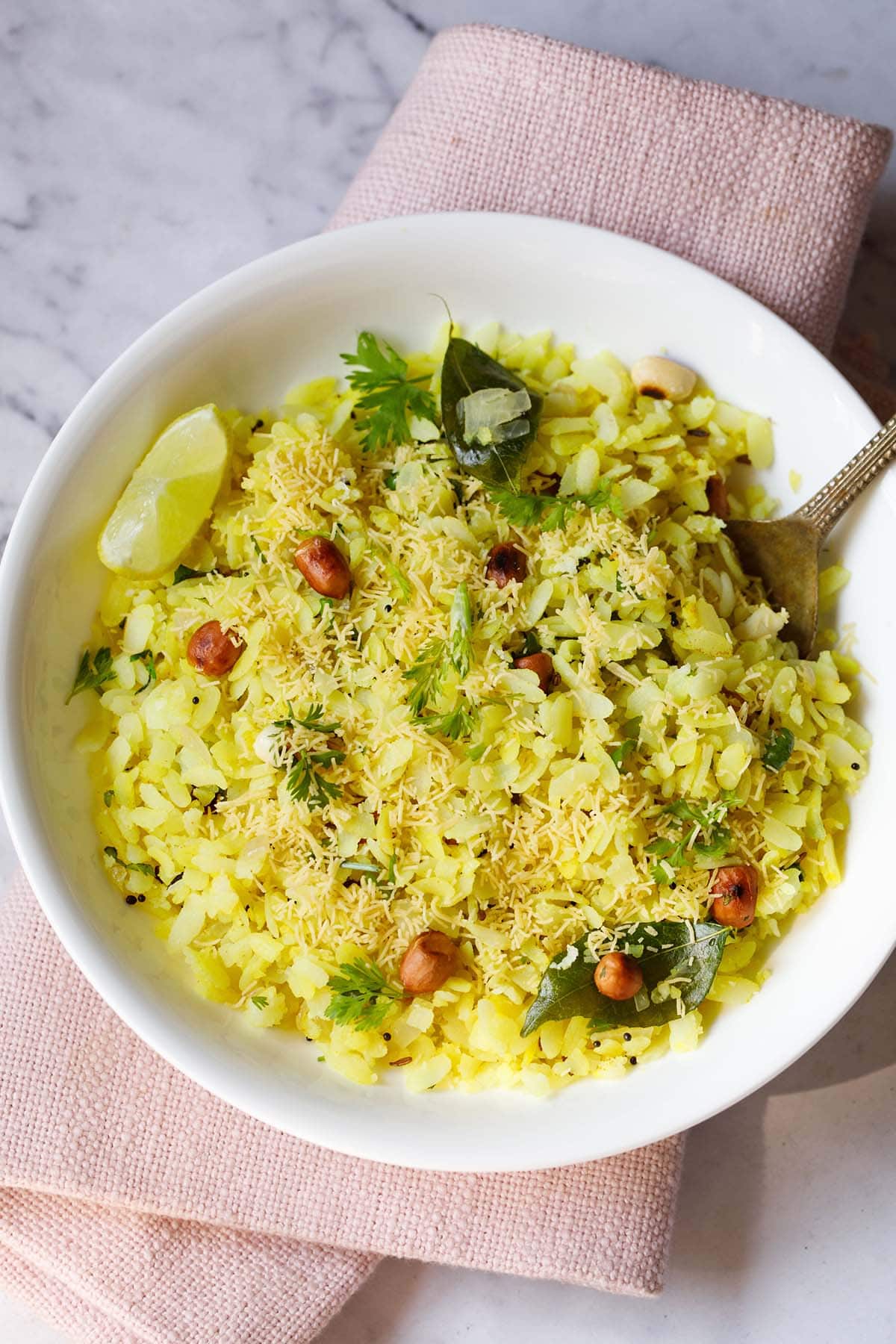
About This Kanda Poha Recipe
The Marathi word ‘kanda’ means onion and ‘poha’ is flattened rice or beaten rice. Hence, when in Maharashtra, you’ll be greeted by the terms Kanda Poha or Kanda Pohe.
This is one of the simple ways to bring in an extra element to the plain Poha recipe. I always add red onions which impart a sweetish taste to the dish. If you are not a fan of this variety of onions, use either white or yellow onions.
As I have mentioned above, I also add potatoes in my recipe. So, imagine flattened rice with both onions and potatoes.
Quite the double bonanza, a feast for your palate. Though you can omit adding potatoes if you prefer.
I also like the flavor of roasted peanuts and coconut in my version. So, I add peanuts always and coconut only when I have it in the kitchen.
This healthy and filling dish is also easy to digest. My perfect way of enjoying it is with a cup of hot tea as a satisfied morning meal.
Whatever way, the dish turns out to be a marvelous one. Super simple, yet flavorful and filling. There are multiple ways in which you can modify this recipe. Each family also has their special recipe.
Generally, it is either with potatoes, onions or both. I add sautéed potatoes, you can opt for boil or steam ones.
How to make Poha Recipe
Preparation
1. Pick 1.5 cups thick or medium-thick poha first. Rinse them in clean running water in a strainer or colander twice or thrice.
Rinsing in fresh clean water softens them as they absorb water.
Make sure not to overdo the rinsing. This will make them mushy and pasty.
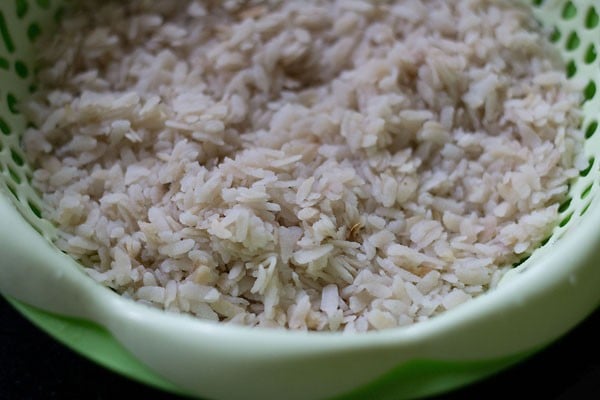
2. Sprinkle ¼ teaspoon turmeric powder, 1 teaspoon sugar (or as required) and salt according to taste on the rinsed poha flakes.
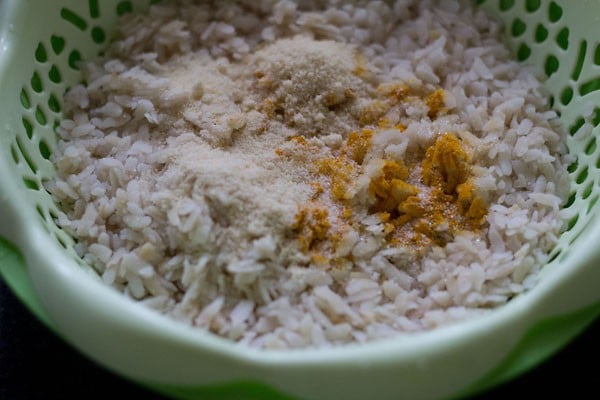
3. Gently mix with your hands or with a spoon.
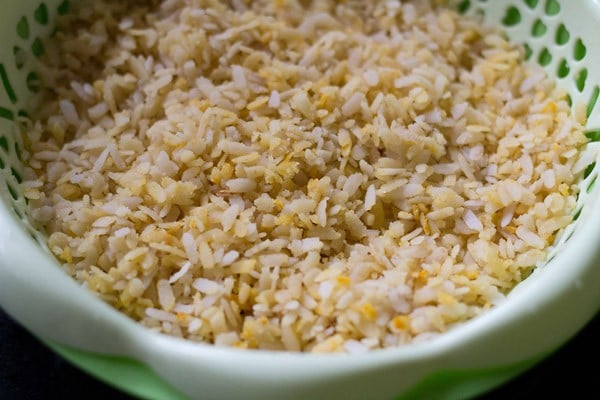
4. Dry roast 2 tablespoons peanuts in a heavy pan on medium-low heat until they become crunchy. Stir often for even cooking of the peanuts.
The peanuts should be roasted well and must not have any rawness in them. Roast till they become crunchy and have a few blisters on their skins.
Once they have roasted well enough, remove them from the pan and set aside in a plate.
Tip: If you like, you can also opt to pan-fry the peanuts in 1 tablespoon of oil.
Note: If you have nut allergy or do not like peanuts, simply choose to omit adding them. As a variation, you can also add cashews if you prefer.
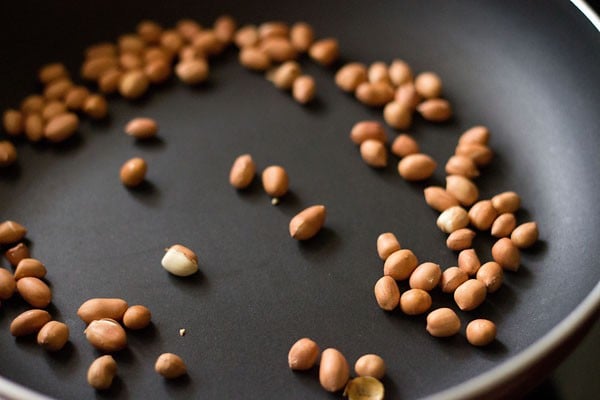
Sauté Potatoes
5. Peel 1 medium to large size potato and chop into small cubes. In the same heavy kadai or pan, heat 2 to 2.5 tablespoons oil. Sauté the potatoes in medium hot oil.
Make sure to cut them in small cubes or else they will take more time to cook.
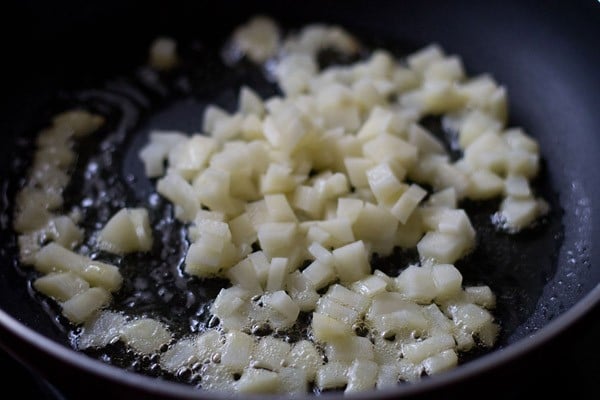
6. Sauté them until light golden and crisp. Stir them often while sautéing. Ensure that the potatoes are cooked soft and tender. They should not be undercooked.
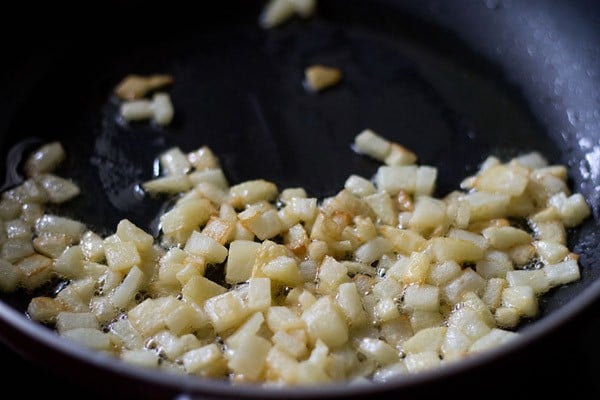
7. Once the potatoes become light golden and crisp, remove them with a slotted spoon draining the extra oil. Keep aside with the roasted peanuts.
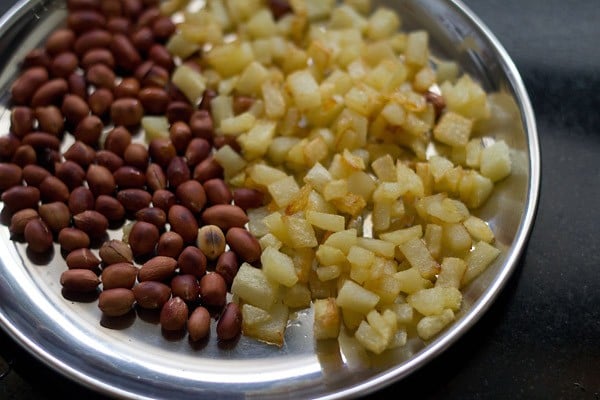
Sauté Spices & Onions
8. In the same kadai, there will be some oil left. Add ½ teaspoon mustard seeds to the hot oil. If there is no oil, add 1 tablespoon oil and heat it gently.
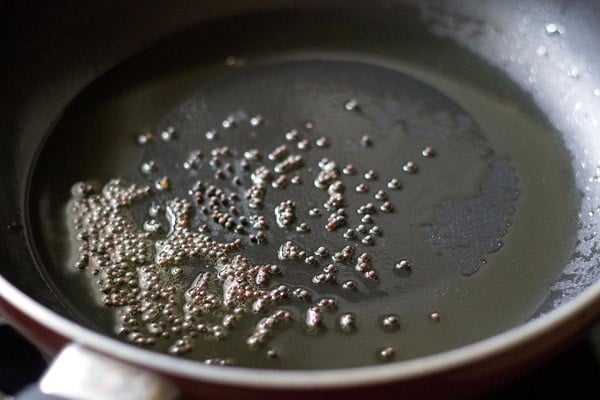
9. When the mustard seeds splutter, add ½ teaspoon cumin seeds.
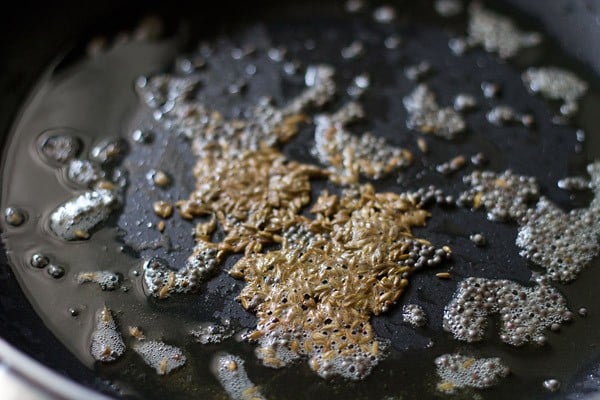
10. When the cumin seeds splutter, add ⅓ cup finely chopped onions. Sauté the onions until they soften and become translucent.
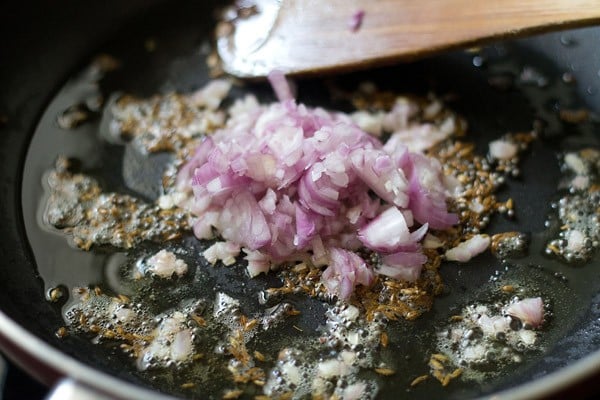
11. Now, add 8 to 9 curry leaves (medium to large size), 1 teaspoon chopped green chilies and the roasted peanuts. Mix well on low heat.
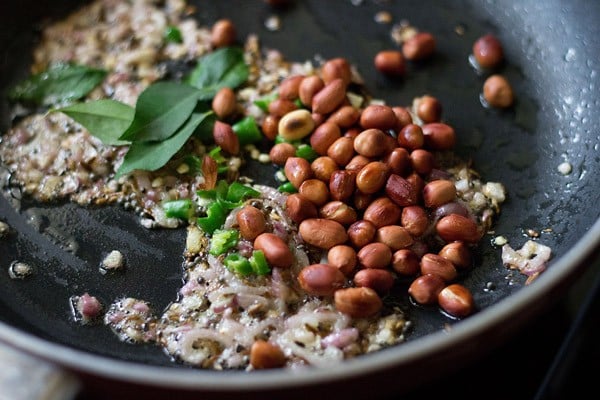
Make Kanda Poha
12. Add the poha.
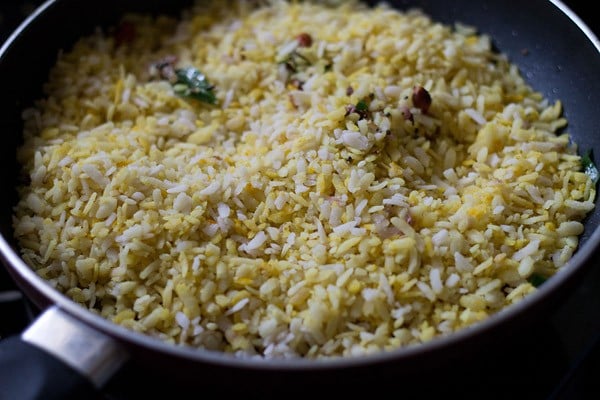
13. Mix gently with the rest of the ingredients.
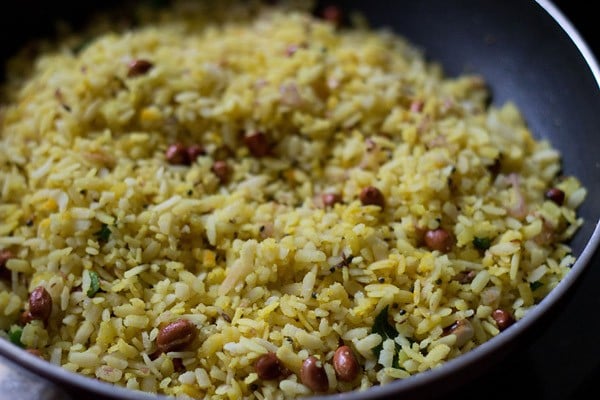
14. Add the potatoes and mix very well. Cover the pan tightly with a lid and steam the poha for about 2 minutes on low heat. Remove the lid and check the taste. If required, add more salt and sugar.
Tip: When you add the potatoes, if the poha flakes look dry to you, sprinkle about 1 to 2 tablespoons of water all over. Stir to mix gently and cover the pan with lid and steam for 2 to 3 minutes on a low heat.
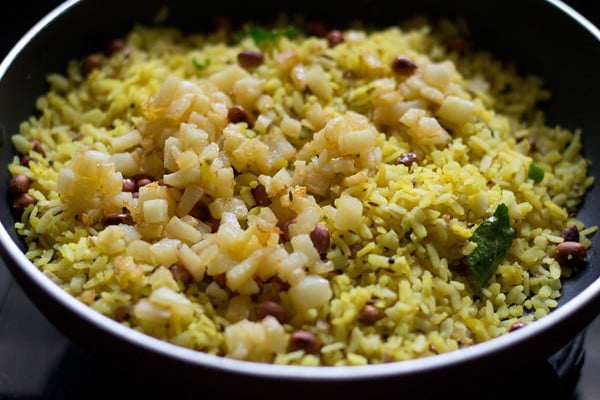
15. Garnish with 2 to 3 tablespoons chopped coriander leaves and 2 to 3 tablespoons grated fresh coconut (optional).
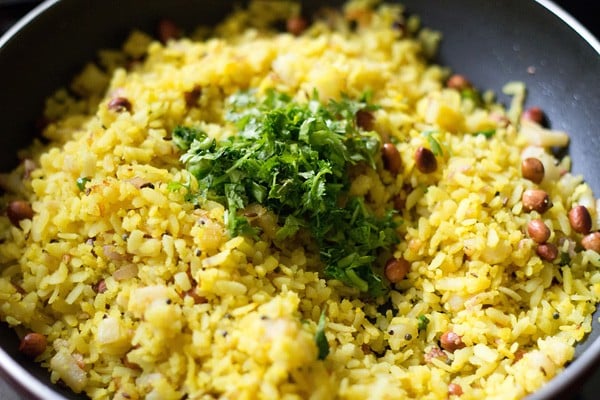
16. Mix gently.
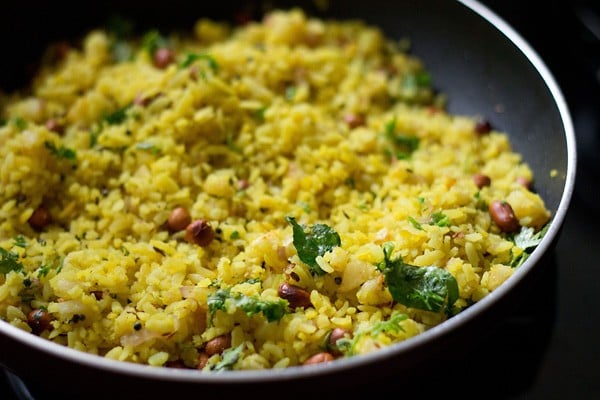
17. Serve Kanda Poha hot or warm with lemon wedges. The lemon juice has to be squeezed on poha before eating it.
Alternatively, you can also follow this method. When the poha recipe is cooked, drizzle about 1 to 2 teaspoons lemon juice on it. Mix well with the poha, garnish with grated coconut and coriander leaves and serve.
You can also top your poha with sev (fine fried gram flour vermicelli) or farsan/mixture if you like.
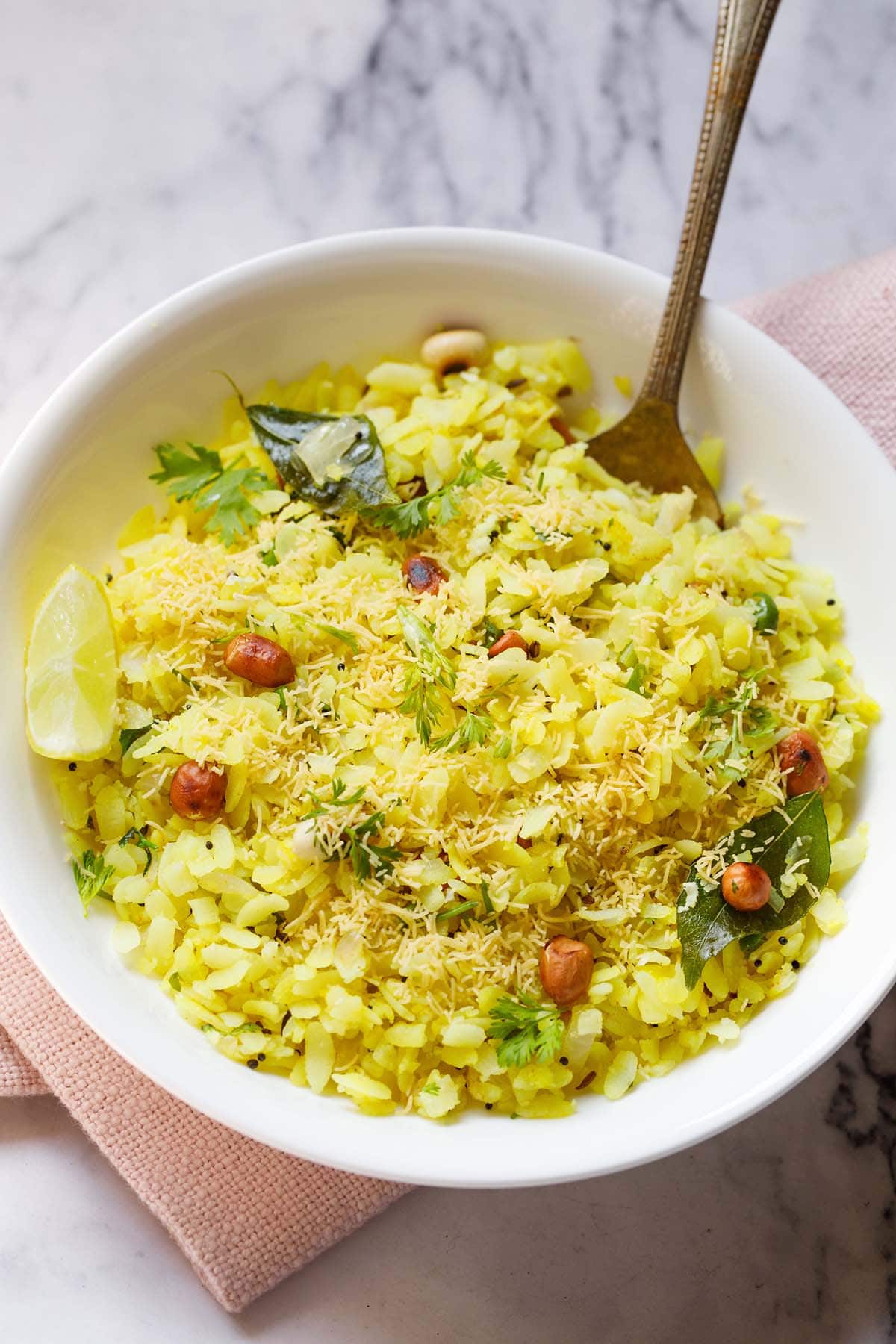
Expert Tips
- Type of Poha: I use both the white and red varieties to make this dish. So both the varieties can be used to make the poha recipe. But always use thick or medium-thick poha to make this breakfast dish. Thin poha will become a mush and pasty after rinsing and cooking.
- Poha Texture: After rinsing, press a beaten rice flake. It will easily crush or mash if it is soft enough. You can cook with this. If not, then it must be still dry. In this case, sprinkle little water on the poha flakes and mix gently.
- Rinsing Poha: I usually use a colander or strainer to rinse the flattened rice flakes under running water and not soak them. Rinsing helps to soften the flakes easily. But take care not to rinse too much or soak them in water as this can make the poha mushy or lumpy.
- Vegetables: To make it healthier, add boiled peas, finely chopped capsicum and grated carrots or your preferred veggies. Steam, boil, sauté, pan-fry the vegetables accordingly before you add to your poha.
- Garnish: I garnish my recipe with coriander leaves and grated fresh coconut. While I would not suggest you to skip the coriander, you can give the coconut a miss. For some cruncy and crispy texture you could also opt to garnish or top Kanda Poha with sev or farsan.
- Taste Preferences: If you don’t like the slight sweet taste in the dish, don’t add sugar. You can also squeeze some lemon juice on the dish before eating it or opt not to. For a spicy poha recipe, add more green chillies. If you like a bit of gingery taste in poha, add about ½ teaspoon of finely chopped or minced ginger.
Poha, The Ingredient
Flattened rice, beaten rice or parched rice are different words that denote the ingredient Poha. It is made by first parboiling and then flattening the rice grains. This results in thin, crisp and dry rice flakes that can be easily broken or crumbled.
Poha in other Indian regional languages – pauwa (Hindi), paunva (Gujarati), chira (Bengali), phov (Konkani), aval (Tamil and Malayalam), atukulu (Telugu) and avalakki (Kannada).
It is easily available in India. But outside India, it can be bought from an Indian/Asian grocery store or online.
Primarily, there are 2 to 3 types of flattened rice sold in the markets – one which is papery thin and the other which is a thick variety and medium-thick variant. While both can be used interchangeably in many recipes, this Poha recipe uses the thicker one.
There are other varieties based on the color. So, we also have red or brown flattened rice made from red or brown rice, respectively. You can make this recipe with either of these as well.
Beaten rice absorbs liquids like water or milk when it is soaked in them. Once soft, you can consume it raw or cook it a bit.
Also, recipes with flattened rice require little to no cooking. Quick snacks like Poha Chivda can also be made by roasting or frying this ingredient.
Pohe, The Dish
This light and nutritious breakfast dish is made by mixing beaten rice with spices, curry leaves and seasonings. In addition to this, onions, potatoes or both onions and potatoes can also be added. You can say that the Poha recipe is a ridiculously easy one.
To increase the nutritional profile, you can also perk up this recipe with grated carrots, boiled green peas, roasted peanuts, cashews and garnish with a generous amount of fresh coriander leaves and grated fresh coconut. When adding potatoes, you can either fry or steam them.
Along with Kanda Poha, another very unique variation of this specific dish is the Indori Poha which is a famous street food from Indore, Madhya Pradesh. It has fennel seeds too. Special toppings are Indori sev, masala boondi, fresh pomegranate pearls, etc.
Apart from Idli, Dosa and Upma, Poha has been a constant in my life since my childhood years. My mother loved making it for breakfast, sometimes for brunch too.
More Indian Breakfast Recipes To Try!
Breakfast Recipes
Breakfast Recipes
North Indian Food
Breakfast Recipes
Please be sure to rate the recipe in the recipe card or leave a comment below if you have made it. For more vegetarian inspirations, Sign Up for my emails or follow me on Instagram, Youtube, Facebook, Pinterest or Twitter.
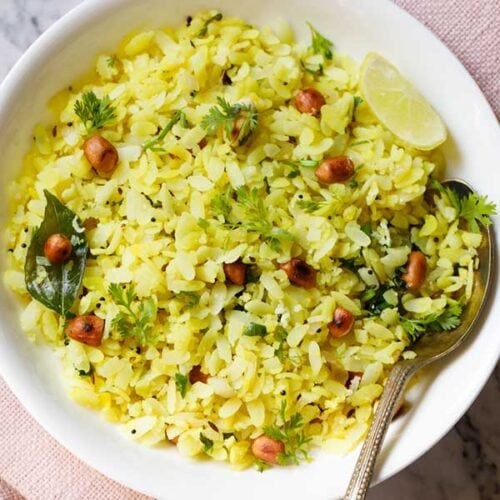
Poha Recipe | Kanda Poha
Ingredients
For prepping poha
- 1.5 cups poha – thick variety (flattened rice or parched rice)
- 1 teaspoon sugar or as required
- salt as required
- ¼ teaspoon turmeric powder (ground turmeric)
Other ingredients
- 2 tablespoons peanuts
- 2 to 2.5 tablespoons oil – peanut, sunflower or any neutral oil
- ½ teaspoon mustard seeds
- ½ teaspoon cumin seeds
- 1 potato – medium-sized, chopped into small cubes
- ⅓ cup onions – finely chopped or 1 medium-sized
- 1 teaspoon green chilies – finely chopped or 1 to 2 green chillies
- 8 to 9 curry leaves (medium to large sized)
- 2 to 3 tablespoons coconut – fresh and grated, optional
- 2 to 3 tablespoons coriander leaves – chopped (cilantro)
Instructions
Preparation
- Pick the poha first of any debris or small stones. Rinse the poha flakes in clean running water in a strainer or colander twice or thrice.
- Make sure that you do not rinse the poha flakes too much or else they break and get mushy. While rinsing, the poha flakes absorb enough water and they become soft.
- The poha must become soft but remain intact, whole and separate. If they do not become soft, add a splash of water on them in the strainer and mix till they get softened.
- After rinsing, the poha flakes should loose their crunchiness and when you break them between your fingers, they should easily get crushed or mashed.
- When the poha have softened nicely, sprinkle the turmeric powder, sugar and salt evenly on the poha. Gently mix with a spoon or with clean fingers.
- Roast the peanuts in a small frying pan till they become crunchy with a few blisters on the peanut skins. Set aside.
- Also peel the potatoes and chop them into small cubes.
Making kanda poha
- In a heavy kadai, heat oil. Sauté the potatoes in medium hot oil till light golden and crisp. Stir them often for even frying.
- Remove the potatoes with a slotted spoon and set aside.
- In the same kadai, there will be some oil left. Add mustard seeds to the hot oil. If there is no oil, then add 1 tablespoon oil and heat it gently and then add the mustard seeds.
- When the mustard seeds splutter, add the cumin seeds.
- When the cumin seeds crackle, add the onions. Sauté the onions till they become translucent and soften.
- Now add the curry leaves, chopped green chillies and roasted peanuts. Sauté for a minute on low heat.
- Add the fried potatoes and then the rinsed poha. Mix gently with the rest of the sautéed ingredients.
- Cover the pan tightly with a lid for the poha to get steamed for about 2 minutes on low heat.
- Remove the lid and check the taste and if required add more salt and sugar.
- Turn off the heat and cover the pan tightly with a lid for the poha to get steamed for a few minutes.
- Remove the lid and garnish with chopped coriander leaves and grated fresh coconut.
- Serve Kanda Poha hot with chopped lemon pieces. The lemon juice has to be squeezed on the poha before eating it.
- Alternatively, you could also follow this method. Once the poha is cooked, sprinkle about 1 to 2 teaspoons lemon juice on it.
- Mix and then garnish it with coconut and coriander leaves.
Video
Notes
- Texture: After rinsing the poha flakes, press a few flakes and if they get crushed or mashed easily then they are soft enough to be cooked. If they are dry or crunchy, add a splash of water on them and gently mix.
- Rinsing: I always rinse these poha flakes in a strainer or colander under running water and don’t soak them in water. Rinsing softens them easily. But if you get a hard variety of poha which do not soften on rinsing, soak them in water for a few minutes until they soften.
- Veggies: To make poha recipe more nutritious, opt to add boiled peas, finely chopped capsicum or grated carrots or your preferred veggies. Chose to steam/boil/sauté/pan fry the vegetable as needed before you add to the poha.
- Garnish: I like to add grated fresh coconut but it is optional. Do add coriander leaves and do not skip them. If you like crunchy and crispy texture, top some sev or mixture or farsan on your poha.
- Type of poha: Both white and red poha can be added in the recipe. Also be sure to use thick or medium-thick variety of poha. Take care not to use thin poha flakes as they will become a mush after rinsing and cooking.
- Flavor & Taste Additions: Adding sugar is optional. You can skip it completely if you don’t prefer a slightly sweet taste in the kanda poha. You could also opt to not add lemon juice to your poha. For a spicy poha, add more green chillies. If you like ginger, feel free to add finely chopped or minced ginger.
- Scaling: Easily scale the recipe to reduce or increase the servings according to your needs.
Nutrition Info (Approximate Values)
This Poha Recipe from the archives was first published in August 2013. It has been updated and republished on March 2023.
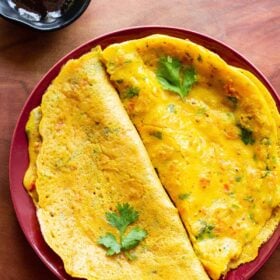
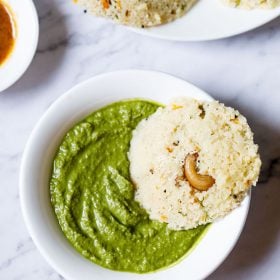

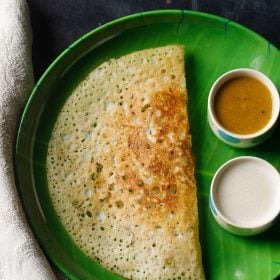











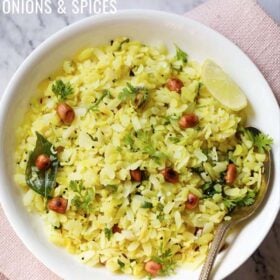
one of my favorite indian breakfast. flattened rice with spices and few roast peanut… oh i missed it so much
Tried the recipe and can definitely say that it is my go through recipe from now onwards. Thanks for sharing this simple yet delicious recipe.
thank you sukanya. glad to know liked the poha recipe. thanks for the rating also.
It was so easy & simple madam, i will also try this recipe & serve to my lovable ones.
Please do more easy recipes which can be done at home
good going
thanks a lot.
its very good
i tryed it it taste good!!
Very tasty Poha
thank you.
This is a delicious and well explained recipe. Ive been making it for years now and turns out perfectly. Thank you for putting it here.
Welcome Nisreen. Thanks for your positive feedback on kanda poha recipe.
Made Poha this morning using ur recipe, it turned out perfect.!Thank o
Welcome Pricilla.
Dear Dassana Ji, my wife ‘ordered me’, to make one cup of cold, wet, poha, without potatoes. (She hates potatoes…). Then she rolled over, and went back to sleep …… since it is a Sunday, and her only day of rest.
But, it is minus 7 oC ouside, and dreary snow on the landscape, and my toes were getting frozen, so I decided to make your hot kanda kandey pohe’. I’m glad, I did, for the hot pohey felt good.
If you will indulge me, I made a few modifications ….
I used salted, pre-roasted peanuts, which I crushed coarsely, with a rolling pin.
Also I put in a pinch of Aamti or sambhaar powder, ( I forget which – ) … for ‘good luck’ …..
I also used coconut oil and a dollop of coconut paste for the ‘salutations’ to some konkani gods,
also I put a small pinch of urad dal and jeera for part of the tadka. This is out of habit. Also I forgot to add turmeric, so the yellow color was missing, but it is so dark, here until 10 am, that I did not even notice the lack of color.
My wife liked it, nevertheless, so I am off the hook …. until tomorrow.
Best Seasons wishes for the Christmas, Hannukkah, KrishnaJayanti, Buddhastami, and Eid. Keep up the good work, and a good sense of humour.
Welcome Vidwan. Seasons greetings to you and your wife also. Glad to read your sweet and humorous comment. Good to know the variations you did to kanda poha. I hope you will be blessed with more cooking skills and will make more people laugh with your humour.
Brilliant recipe
To the point
Came out perfect when I made it.
Thank you ????
thanks sejal for the positive feedback in kanda poha recipe. glad you liked it.
ITried this today for breakfast. It was tasty, perfect poha recipe. Thanks
Welcome Lata
Made Poha for the first time by seeing this simple recipe and it wasn’t that bad. Thanks a lot.
Welcome Shiva
I always make poha. But myhusband complaint about texture and taste, than I tried your recipe ahd he loved it. Thank you so much for tasty recipe
thats nice to know falguni. thanks for the feedback.